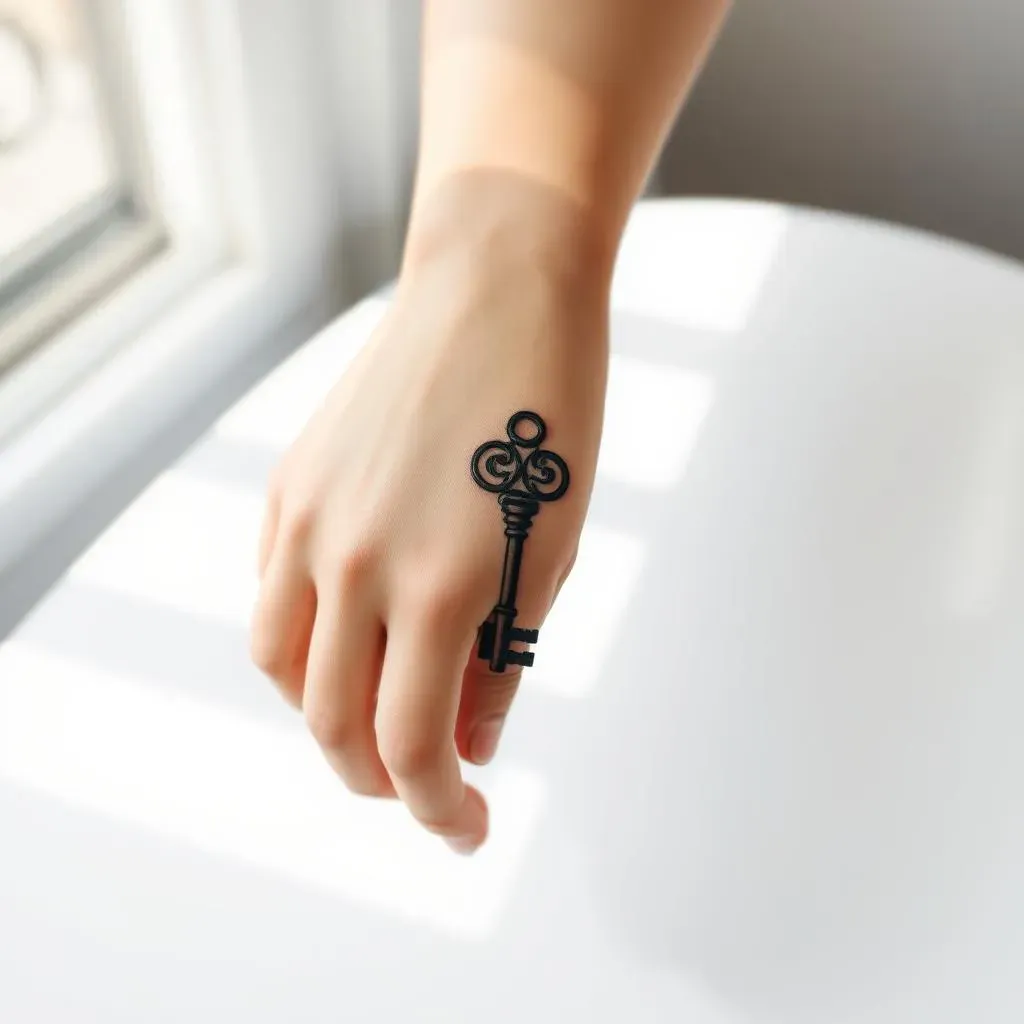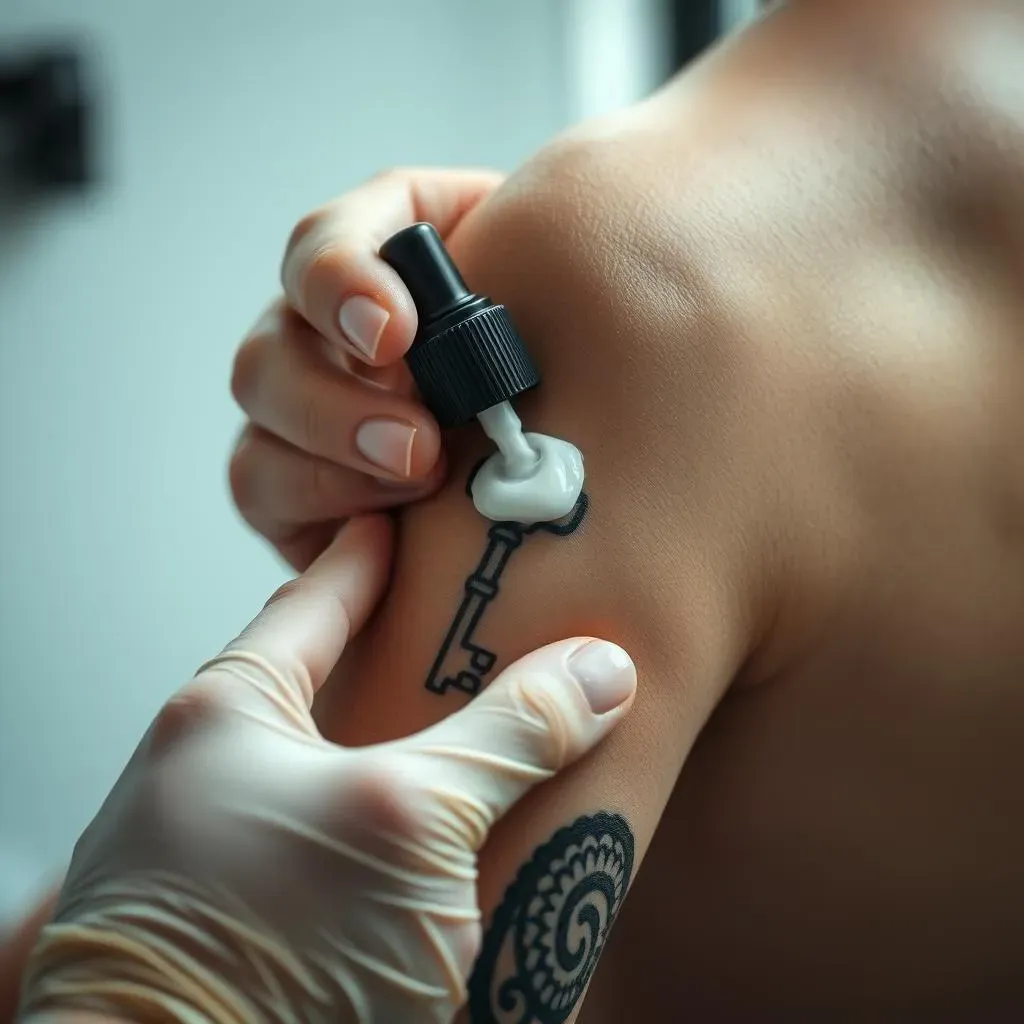Table of Contents
Thinking about getting a tattoo but not sure what design to choose? Key tattoos for women are becoming increasingly popular, and for good reason! They're elegant, versatile, and packed with symbolic meaning. This article is your ultimate guide to unlocking the world of key tattoos. We'll explore the rich symbolism associated with keys, delving into what they represent – from unlocking potential to representing new beginnings and hidden secrets. Prepare to be inspired by a stunning showcase of popular key tattoo designs, perfect for women who want a meaningful and stylish piece of body art. We'll also discuss ideal placement and size options to help you find the perfect spot for your new tattoo. Finally, we'll equip you with essential aftercare tips to ensure your key tattoo remains vibrant and beautiful for years to come. So, whether you're a seasoned tattoo enthusiast or a first-timer, get ready to discover the perfect key tattoo to unlock your unique style. Let's dive in!
The Symbolism of Keys: What Do They Represent?

The Symbolism of Keys: What Do They Represent?
So, you're curious about the symbolism of keys? It's a fascinating topic! Keys aren't just for opening doors, you know. They're powerful symbols with deep meaning, especially when it comes to tattoos. Think about it – a key unlocks something hidden, something secret, something special. That's the essence of their symbolic power. In many cultures, keys represent access, opportunity, and new beginnings. A key tattoo can symbolize unlocking your potential, opening up new paths in life, or even finding the key to your own happiness. It's a reminder that you hold the power to unlock your own destiny.
For women, a key tattoo can carry even more profound meaning. It might represent unlocking inner strength, independence, or the ability to overcome challenges. It could symbolize a pivotal moment in life, a breakthrough, or a journey of self-discovery. The possibilities are endless! Want to subtly hint at a hidden side? Check out these symbolic tattoos for more ideas. Consider the specific type of key, too. A skeleton key, for example, often symbolizes unlocking ancient mysteries or hidden knowledge. A more modern key might represent a more contemporary sense of unlocking new opportunities. The design itself can add layers of meaning, making it even more personal and significant.
Type of Key | Symbolic Meaning |
|---|---|
Skeleton Key | Mystery, hidden knowledge, access to secrets |
Modern Key | New beginnings, opportunities, progress |
Ornate Key | Elegance, sophistication, unique identity |
It's all about personal interpretation, of course. What does a key represent *to you*? What feeling do you want your tattoo to evoke? That's the most important question to ask yourself when choosing a key tattoo design. Thinking about other symbolic tattoos? Maybe a infinity tattoo would complement your key design.
And remember, the beauty of a key tattoo lies in its simplicity and versatility. It can be small and delicate, or large and bold, making it adaptable to any style. You can incorporate other elements into your design, such as flowers, hearts, or other symbolic imagery, to personalize it further. It’s your story, your key, your tattoo. Do you want a super detailed design? Or something more minimalist? That's entirely up to you. And speaking of designs, let's look at some popular choices for women.
- Vintage keys
- Skeleton keys
- Keys with flowers or other embellishments
- Keys with lock and key designs
“A key is a small thing, but it can open a big door.” - Unknown
Popular Key Tattoo Designs for Women

Popular Key Tattoo Designs for Women
Vintage Keys: A Touch of Old-World Charm
Vintage keys are a timeless choice, exuding elegance and a touch of mystery. Their intricate details and aged appearance make them visually striking, and they often evoke a sense of nostalgia and history. Think delicate filigree, ornate handles, and the subtle patina of time. A vintage key tattoo can be a beautiful way to represent a connection to the past, a cherished memory, or a love for antique aesthetics. They're incredibly versatile, too – you can add a small flourish like a tiny flower or a ribbon for a touch of personalization. Small and dainty? Or big and bold? It's all up to you!
Consider the overall style you're going for. Do you want a highly detailed, realistic rendering of a vintage key, complete with all its tiny grooves and flourishes? Or would you prefer a simpler, more minimalist design that captures the essence of the key without being overly fussy? Looking for other ideas? Check out these symbolic tattoo ideas for inspiration.
- Placement: Wrist, ankle, finger
- Style: Realistic, minimalist, watercolor
- Additions: Flowers, ribbons, initials
Skeleton Keys: Unlocking Secrets and Mysteries
Skeleton keys, with their distinctive shape and simple design, hold a unique appeal. Often associated with hidden passages, secret societies, and untold stories, they symbolize the unlocking of mysteries and the discovery of hidden truths. A skeleton key tattoo can represent a journey of self-discovery, a hidden talent, or a quest for knowledge. Their simple yet striking design makes them a popular choice for those who prefer a more understated yet powerful statement. Consider pairing a skeleton key with a meaningful quote or symbol to further enhance its personal significance.
The clean lines of a skeleton key lend themselves well to various styles, from minimalist black ink to more intricate designs with added details. Consider adding a small charm or a tiny detail to personalize the design further and make it truly your own. Need some additional inspiration? Take a peek at some lovely moon tattoos – they often have a similar mystical vibe.
Style | Description |
|---|---|
Minimalist | Simple outline, black ink |
Detailed | Intricate shading, added elements |
Geometric | Clean lines, sharp angles |
Keys with Flowers or Other Embellishments: Adding a Personal Touch
Want to infuse your key tattoo with even more personality? Consider adding elements like flowers, hearts, or other meaningful symbols. Flowers, for instance, can add a touch of femininity and beauty, while hearts represent love and connection. The possibilities are endless, allowing you to create a truly unique and personalized design that reflects your individual style and preferences. This is a fantastic way to blend different tattoo styles and create a truly bespoke piece of art.
Think about what other symbols resonate with you and how you can integrate them into your key tattoo design. This is all about creating a tattoo that tells *your* story. Do you love nature? Consider incorporating leaves or flowers. Are you a spiritual person? Maybe a chakra tattoo would be a perfect addition. The options are limitless!
Placement and Size: Finding the Perfect Spot for Your Key Tattoo

Placement and Size: Finding the Perfect Spot for Your Key Tattoo
Choosing the right placement and size for your key tattoo is crucial! It's all about finding a spot that complements the design and your personal style. Think about how visible you want your tattoo to be. Do you want it to be a subtle accent, or a bold statement? The size of your key tattoo will play a significant role in its overall impact. A small, delicate key might look perfect on your wrist or ankle, while a larger, more intricate design could be stunning on your ribcage or back. Consider your pain tolerance, too. Some areas are more sensitive than others.
Popular placement options for key tattoos include the wrist, ankle, finger, ribs, and behind the ear. The wrist is a classic choice, offering a delicate and easily visible spot. The ankle, similarly, offers a charming and slightly hidden location. Fingers, while small, can be perfect for minimalist key designs. For larger, more detailed designs, the ribs or back offer ample space. Behind the ear is another unique spot for a small and discreet key tattoo. Want a totally different kind of tattoo? Check out these feather tattoos!
Placement | Pros | Cons |
|---|---|---|
Wrist | Visible, delicate | Can fade faster |
Ankle | Charming, slightly hidden | Can be hard to see |
Ribcage | Large space, bold statement | Can be painful |
When it comes to size, consider the level of detail in your key design. A highly detailed vintage key might require more space to showcase its intricate features. A simpler skeleton key, on the other hand, can be effectively rendered in a smaller size. Remember, the size of your tattoo should be proportionate to the area where you plan to place it. A tiny key on your back might get lost, while a huge key on your finger would be impractical. Also, don't forget to consult with your tattoo artist to ensure your chosen size and placement are feasible and will create the best possible outcome. If you're still feeling unsure, more symbolic tattoo ideas might inspire you.
Ultimately, the best placement and size for your key tattoo are a matter of personal preference and what feels right for you. Consider your lifestyle, your clothing style, and how much you want your tattoo to be visible. Think carefully about the overall look you're aiming for, and don't hesitate to discuss your ideas with your tattoo artist. They're experts who can offer valuable insights and help you make an informed decision. And if you're still feeling overwhelmed by choices, consider checking out these mandala tattoos – they offer a different kind of symbolic beauty.
- Consult with a tattoo artist
- Consider your lifestyle and clothing
- Think about visibility and pain tolerance
Caring for Your Key Tattoo: Tips for LongLasting Ink

Caring for Your Key Tattoo: Tips for LongLasting Ink
Protecting Your New Ink: The First Few Weeks
So, you've got your gorgeous new key tattoo! Congratulations! Now, the crucial part: aftercare. The first few weeks are vital for healing and preventing infection. Your tattoo artist will give you specific instructions, but here's the general gist. Keep the area clean – gently wash it with antibacterial soap and lukewarm water twice a day. Pat it dry (don't rub!), and apply a thin layer of the recommended ointment. Avoid swimming pools, hot tubs, and excessive sun exposure. These things can irritate your skin and hinder the healing process. Think of your tattoo like a delicate new plant; it needs tender loving care to flourish.
Avoid picking or scratching at scabs. I know, it itches! But resist the urge. Picking can lead to scarring and damage your beautiful new ink. If you're feeling really itchy, try applying a cool compress. It'll help soothe the irritation without harming your tattoo. And remember, everyone heals at a different pace. Don't compare your healing process to others. Be patient and focus on following your artist's advice for the best results. For more unique designs, check out these symbolic tattoo ideas.
- Wash gently with antibacterial soap
- Pat dry, don't rub
- Apply thin layer of ointment
- Avoid sun, pools, hot tubs
- Don't pick or scratch scabs
Long-Term Care: Keeping Your Tattoo Vibrant
Once your tattoo is fully healed (usually 2-4 weeks), the aftercare changes, but the focus on protection remains. Keep your skin moisturized! Dry skin can lead to fading, so apply a good quality unscented lotion regularly. This helps maintain the vibrancy of your ink and keeps the skin healthy. Also, remember that sun exposure is a major culprit in tattoo fading. Always use a high SPF sunscreen (at least 30) when your tattoo will be exposed to the sun. This is especially important during peak sun hours. Sun protection is a key element in preserving the longevity of your tattoo.
Regular moisturizing is essential, but avoid using harsh chemicals or perfumed lotions that could irritate your skin. Simple, unscented lotions are best. Think of it as a daily ritual to keep your artwork looking its best. And if you notice any unusual changes – redness, swelling, or excessive pain – contact your tattoo artist immediately. It's always better to be safe than sorry. Want to explore more expressive designs? Check out these feather tattoo designs.
Aftercare Step | Frequency | Purpose |
|---|---|---|
Moisturize | Daily | Prevent fading, keep skin healthy |
Sunscreen | Before sun exposure | Protect from UV damage |
Addressing Common Concerns: Fading, Blemishes, and More
Even with proper care, some fading is inevitable over time. This is a natural part of the tattoo aging process. However, you can minimize fading by following the tips mentioned above, particularly sun protection. Sometimes, small blemishes or imperfections may appear. These are often due to minor scarring or healing inconsistencies. Usually, these are not cause for alarm, but if you're concerned, consult your artist. They can advise on any necessary touch-ups or address any underlying issues.
Remember, your tattoo is a work of art, and like any artwork, it requires care and attention to maintain its beauty. By following these simple steps, you can help ensure that your key tattoo remains vibrant and stunning for years to come. It's a small investment of time and effort for a lifetime of enjoyment. And, if you want something a little different, have a look at these moon tattoos for inspiration. They're equally beautiful and symbolic.